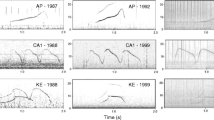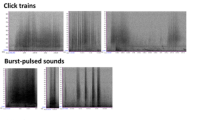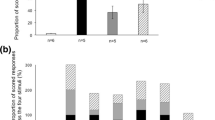Abstract
Public signaling plays an important role in territorial and sexual displays in animals; however, in certain situations, it is advantageous to keep signaling private to prevent eavesdropping by unintended receivers. In the northeastern Pacific, two populations of killer whales (Orcinus orca), fish-eating “resident” killer whales and mammal-eating “transient” killer whales, share the same habitat. Previous studies have shown that residents use whistles as private signals during close-range communication, where they probably serve to coordinate behavioral interactions. Here, we investigated the whistling behavior of mammal-eating killer whales, and, based on divergent social structures and social behaviors between residents and transients, we predicted to find differences in both whistle usage and whistle parameters. Our results show that, like resident killer whales, transients produce both variable and stereotyped whistles. However, clear differences in whistle parameters between ecotypes show that the whistle repertoire of mammal-eating killer whales is clearly distinct from and less complex than that of fish-eating killer whales. Furthermore, mammal-eating killer whales only produce whistles during “milling after kill” and “surface-active” behaviors, but are almost completely silent during all other activities. Nonetheless, whistles of transient killer whales may still serve a role similar to that of resident killer whales. Mammal-eating killer whales seem to be under strong selection to keep their communication private from potential prey (whose hearing ranges overlap with that of killer whales), and they appear to accomplish this mainly by restricting vocal activity rather than by changes in whistle parameters.



Similar content being viewed by others
References
Au WWL, Popper AN, Fay RR (2000) Hearing by whales and dolphins. Springer, New York
Baird RW, Dill LM (1996) Ecological and social determinants of group size in transient killer whales. Behav Ecol 7:408–416
Baird RW, Whitehead H (2000) Social organization of mammal-eating killer whales: group stability and dispersal patterns. Can J Zool 78:2096–2105
Barrett-Lennard LG (2000) Population structure and mating system patterns of killer whales, Orcinus orca, as revealed by DNA analysis. Ph.D. thesis, University of British Columbia, Vancouver
Barrett-Lennard LG, Ford JKB, Heise KA (1996) The mixed blessing of echolocation: differences in sonar use by fish-eating and mammal-eating killer whales. Anim Behav 51:553–565
Berta A, Sumich JL, Kovacs KM (2006) Marine mammals, evolutionary biology, 2nd edn. Academic, Elsevier, Burlington, London, San Diego
Caldwell MC, Caldwell DK (1971) Statistical evidence for individual signature whistles in Pacific white-sided dolphins, Lagenorhynchus obliquidens. Cetology 3:1–9
Dabelsteen T (2005) Public, private or anonymous? Facilitating and countering eavesdropping. In: McGregor PK (ed) Animal communication networks. Cambridge University Press, Cambridge, pp 38–62
Deecke VB (2003) The vocal behaviour of transient killer whales (Orcinus orca): communicating with costly calls. Ph.D. thesis, University of St. Andrews, St. Andrews UK
Deecke VB, Janik VM (2006) Automated categorization of bioacoustic signals: avoiding perceptual pitfalls. J Acoust Soc Am 119:645–653
Deecke VB, Ford JKB, Spong P (2000) Dialect change in resident killer whales: implications for vocal learning and cultural transmission. Anim Behav 60:629–638
Deecke VB, Slater PJB, Ford JKB (2002) Selective habituation shapes acoustic predator recognition in harbour seals. Nature 420:171–173
Deecke VB, Ford JKB, Slater PJB (2005) The vocal behaviour of mammal-eating killer whales: communicating with costly calls. Anim Behav 69:395–405
Deecke VB, Barrett-Lennard LG, Spong P, Ford JKB (2010) The structure of stereotyped calls reflects kinship and social affiliation in resident killer whales (Orcinus orca). Naturwissenschaften 97:513–518
Ellis GM, Towers JR, Ford JKB (2008) Transient killer whales of British Columbia and Southeast Alaska - Photo Identification Catalog 2008. 48pp. Nanaimo, BC: Pacific Biological Station, Fisheries and Oceans Canada. http://www.pac.dfo-mpo.gc.ca/sci/sa/cetacean/default_e.htm
Fenton MB (2003) Eavesdropping on the echolocation and social calls of bats. Mamm Rev 33:193–204
Foote AD, Griffin RM, Howitt D, Larsson L, Miller PJO, Hoelzel AR (2006) Killer whales are capable of vocal learning. Biol Lett 2:509–512
Ford JKB (1984) Call traditions and vocal dialects of killer whales (Orcinus orca) in British Columbia. Ph.D. thesis, University of British Columbia, Vancouver, BC
Ford JKB (1989) Acoustic behaviour of resident killer whales (Orcinus orca) off Vancouver Island, British Columbia. Can J Zool 67:727–745
Ford JKB (1991) Vocal traditions among resident killer whales (Orcinus orca) in coastal waters of British Columbia, Canada. Can J Zool 69:1454–1483
Ford JKB, Ellis GM (1999) Transients: mammal-hunting killer whales of British Columbia, Washington, and Southeastern Alaska. University of British Columbia Press, Vancouver
Ford JKB, Ellis GM, Barrett-Lennard L, Morton AB, Palm R, Balcomb KC (1998) Dietary specialization in two sympatric populations of killer whales (Orcinus orca) in coastal British Columbia and adjacent waters. Can J Zool 76:1456–1471
Ford JKB, Ellis GM, Balcomb KC (2000) Killer whales, 2nd edn. University of British Columbia Press, Vancouver
Fullard JH, Dawson JW (1997) The echolocation calls of the spotted bat Euderma maculatum are relatively inaudible to moths. J Exp Biol 200:129–137
Gotelli NJ, Ellison AM (2004) A primer of ecological statistics. Sinauer Associates, Sunderland
Guinet C (1992) Comportement de chasse des orques (Orcinus orca) autour des îles Crozet. Can J Zool 70:1656–1667
Hoelzel AR, Osborne RW (1986) Killer whale call characteristics: implications for cooperative foraging strategies. In: Kirkevolt BC, Lockard JS (eds) Behavioral biology of killer whales. AR Liss, New York, pp 373–403
Holland J, Dabelsteen T, Pedersen SB, Larsen ON (1998) Degradation of wren Troglodytes troglodytes song: implications for information transfer and ranging. J Acoust Soc Am 103:2154–2166
Janik VM (1999) Pitfalls in the categorization of behaviour: a comparison of dolphin whistle classification methods. Anim Behav 57:133–143
Janik VM (2009) Acoustic communication in delphinids. Adv Study Behav 40:123–157
Janik VM, Slater PJB (1998) Context-specific use suggests that bottlenose dolphin signature whistles are cohesion calls. Anim Behav 56:829–838
Jefferson TA, Stacey PJ, Baird RW (1991) A review of killer whale interactions with other marine mammals: predation to coexistence. Mamm Rev 21:151–180
Marler P, Tenaza R (1977) Signalling behavior of apes with special reference to vocalization. In: Sebeok TA (ed) How animals communicate. Indiana University Press, Bloomington, London, pp 965–1033
McGregor PK, Otter K, Peake TM (1999) Communication networks: receiver and signaller perspectives. In: Espmark Y, Amundsen T, Rosenqvist G (eds) Animal signals: signalling and signal design in animal communication. Tapir Academic Press, Trondheim, pp 405–416
Miller PJO (2002) Mixed-directionality of killer whale stereotyped calls: a direction of movement cue? Behav Ecol Sociobiol 52:262–270
Miller PJO (2006) Diversity in sound pressure levels and estimated active space of resident killer whale vocalizations. J Comp Physiol A 192:449–459
Miller PJO, Bain DE (2000) Within-pod variation in the sound production of a pod of killer whales, Orcinus orca. Anim Behav 60:617–628
Miller PJO, Shapiro AD, Tyack PL, Solow AR (2004) Call-type matching in vocal exchanges of free-ranging resident killer whales, Orcinus orca. Anim Behav 67:1099–1107
Miller PJO, Samarra FIP, Perthuison AD (2007) Caller sex and orientation influence spectral characteristics of “two-voice” stereotyped calls produced by free-ranging killer whales. J Acoust Soc Am 121:3932–3937
Morin PA, Archer FI, Foote AD, Vilstrup J, Allen EE, Wade P, Durban J, Parsons K, Pitman R, Li L, Bouffard P, Abel Nielsen SC, Rasmussen M, Willerslev E, Gilbert MTP, Harkins T (2010) Complete mitochondrial genome phylogeographic analysis of killer whales (Orcinus orca) indicates multiple species. Genome Res 20:908–916
Mougeot F, Bretagnolle V (2000) Predation as a cost of sexual communication in nocturnal seabirds: an experimental approach using acoustic signals. Anim Behav 60:647–656
Nousek AE, Slater PJB, Wang C, Miller PJO (2006) The influence of social affiliation on individual vocal signatures of northern resident killer whales (Orcinus orca). Biol Lett 2:481–484
Peake TM (2005) Eavesdropping in communication networks. In: McGregor PK (ed) Animal communication networks. Cambridge University Press, Cambridge, pp 13–37
Popper AN (1980) Sound emission and detection by delphinids. In: Herman LM (ed) Cetacean behavior: mechanisms and functions. Wiley, New York, pp 1–49
Rehn N, Teichert S, Thomsen F (2007) Structural and temporal emission patterns of variable pulsed calls in free-ranging killer whales (Orcinus orca). Behaviour 144:307–329
Riesch R, Ford JKB, Thomsen F (2006) Stability and group specificity of stereotyped whistles in resident killer whales, Orcinus orca, off British Columbia. Anim Behav 71:79–91
Riesch R, Ford JKB, Thomsen F (2008) Whistle sequences in wild killer whales (Orcinus orca). J Acoust Soc Am 124:1822–1829
Ryan MJ, Tuttle MD, Taft LK (1981) The costs and benefits of frog chorusing behavior. Behav Ecol Sociobiol 8:273–278
Samarra FIP, Deecke VB, Vinding K, Rasmussen MH, Swift RJ, Miller PJO (2010) Killer whales (Orcinus orca) produce ultrasonic whistles. J Acoust Soc Am 128:EL205–EL210
Saulitis EL, Matkin CO, Barrett-Lennard LG, Heise KA, Ellis GM (2000) Foraging strategies of sympatric killer whale (Orcinus orca) populations in Prince William Sound. Mar Mamm Sci 16:94–109
Saulitis EL, Matkin CO, Fay FH (2005) Vocal repertoire and acoustic behavior of the isolated AT1 killer whale subpopulation in southern Alaska. Can J Zool 83:1015–1029
Siegel S, Castellan NJ Jr (1988) Nonparametric statistics for the behavioral sciences, 2nd edn. McGraw-Hill, New York
Slater PJB (2003) Fifty years of bird song research: a case study in animal behaviour. Anim Behav 65:633–639
Thomsen F, Franck D, Ford JKB (2001) Characteristics of whistles from the acoustic repertoire of resident killer whales (Orcinus orca) off Vancouver Island. J Acoust Soc Am 109:1240–1246
Thomsen F, Franck D, Ford JKB (2002) On the communicative significance of whistles in wild killer whales (Orcinus orca). Naturwissenschaften 89:404–407
Tyack PL (1998) Acoustic communication under the sea. In: Hopp SL, Owren MJ, Evans CS (eds) Animal acoustic communication – sound analysis and research methods. Springer, Berlin, Heidelberg, pp 163–220
Wagner WE, Basolo AL (2007) Host preferences in a phonotactic parasitoid of field crickets: the relative importance of host song characters. Ecol Entomol 32:478–484
Watwood SL, Tyack PL, Wells RS (2004) Whistle sharing in paired male bottlenose dolphins, Tursiops truncatus. Behav Ecol Sociobiol 55:531–543
Weiß BM, Symonds H, Spong P, Ladich F (2010) Call sharing across vocal clans of killer whales: Evidence for vocal imitation? Mar Mammal Sci (in press)
Windmill JFC, Jackson JC, Tuck EJ, Robert D (2005) Keeping up with bats: dynamic auditory tuning in a moth. Curr Biol 16:2418–2423
Zuk M, Kolluru GR (1998) Exploitation of sexual signals by predators and parasitoids. Q Rev Biol 73:415–438
Acknowledgments
We thank N. A. Black, D. R. Matkin, G. M. Ellis, B. Ford, J. K. B. Ford, P. D. Goley, J. K. Jacobsen, A. B. Morton, R. Palm, and P. Spong for providing additional recordings of transient killer whales. D. H. Chadwick, M. deRoos, B. Gisborne, F. Nicklin, and P. A. Presi provided essential help with the fieldwork, and V. Livaditis helped with the analysis of focal follows. We are grateful to G. M. Ellis for his help with all aspects of this study, especially for supplying information on the identity of killer whale groups. L. G. Barrett-Lennard, J. and M. Borrowman, John K.B. Ford, C. O. Matkin, D. R. Matkin, J. M. Straley, as well as the staff of Glacier Bay National Park and Preserve provided valuable logistic support. We thank R. Martin (trial run), and E. Hassell, J. Heinen, and K. Quigley for participation in the interobserver reliability study. Two anonymous reviewers greatly helped improved previous versions of the manuscript with their comments and suggestions. All research was conducted under valid research permits from the US National Marine Fisheries Service (permits no. 545-1488-02 and 473 1433 04), Fisheries and Oceans Canada (Marine Mammal Licence 2006-19), and Glacier Bay National Park and Preserve (permit no. GLBA 00016). The fieldwork was funded by the Vancouver Aquarium Marine Science Centre, BC Wild Killer Whale Adoption Program, as well as National Oceanographic and Atmospheric Administration, and North Pacific Marine Science Foundation through the North Pacific Universities Marine Mammal Consortium.
Author information
Authors and Affiliations
Corresponding author
Additional information
Communicated by G. Jones
Electronic supplementary materials
Below is the link to the electronic supplementary material.
ESM 1
(DOC 187 kb)
Rights and permissions
About this article
Cite this article
Riesch, R., Deecke, V.B. Whistle communication in mammal-eating killer whales (Orcinus orca): further evidence for acoustic divergence between ecotypes. Behav Ecol Sociobiol 65, 1377–1387 (2011). https://doi.org/10.1007/s00265-011-1148-8
Received:
Revised:
Accepted:
Published:
Issue Date:
DOI: https://doi.org/10.1007/s00265-011-1148-8




